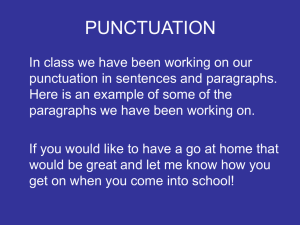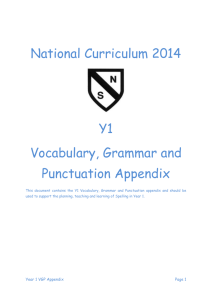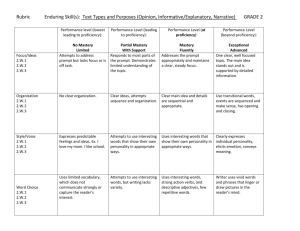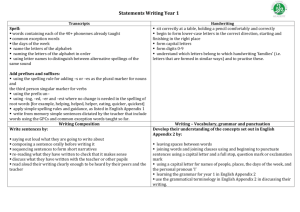Writing Targets Information for Parents
advertisement
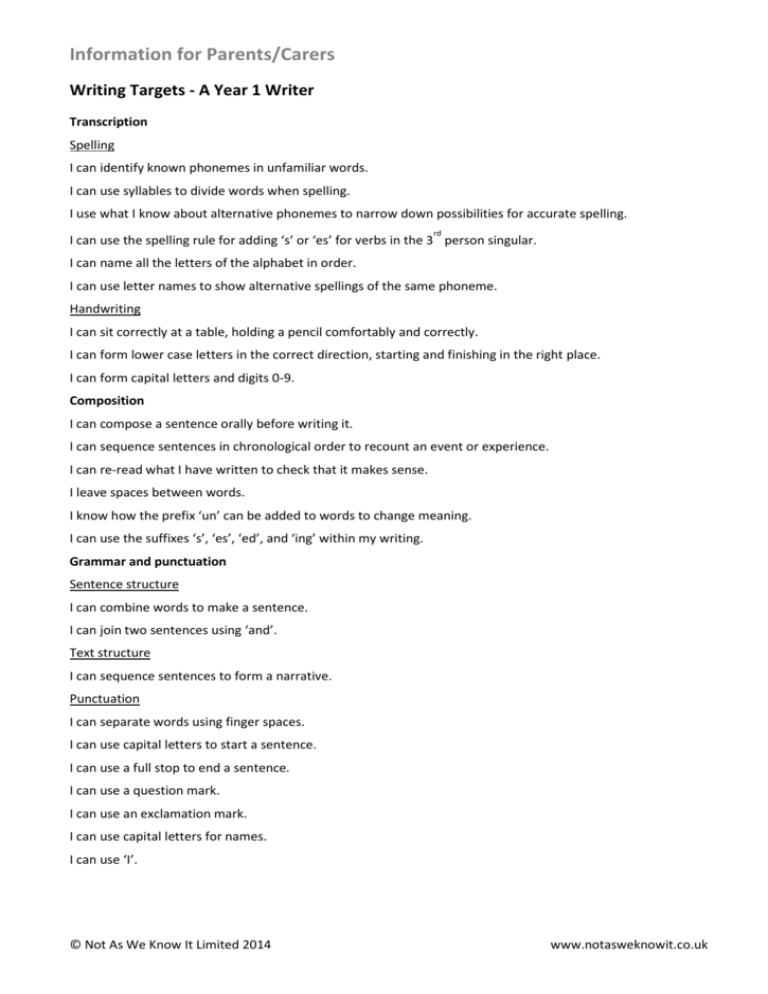
Information for Parents/Carers Writing Targets - A Year 1 Writer Transcription Spelling I can identify known phonemes in unfamiliar words. I can use syllables to divide words when spelling. I use what I know about alternative phonemes to narrow down possibilities for accurate spelling. rd I can use the spelling rule for adding ‘s’ or ‘es’ for verbs in the 3 person singular. I can name all the letters of the alphabet in order. I can use letter names to show alternative spellings of the same phoneme. Handwriting I can sit correctly at a table, holding a pencil comfortably and correctly. I can form lower case letters in the correct direction, starting and finishing in the right place. I can form capital letters and digits 0-9. Composition I can compose a sentence orally before writing it. I can sequence sentences in chronological order to recount an event or experience. I can re-read what I have written to check that it makes sense. I leave spaces between words. I know how the prefix ‘un’ can be added to words to change meaning. I can use the suffixes ‘s’, ‘es’, ‘ed’, and ‘ing’ within my writing. Grammar and punctuation Sentence structure I can combine words to make a sentence. I can join two sentences using ‘and’. Text structure I can sequence sentences to form a narrative. Punctuation I can separate words using finger spaces. I can use capital letters to start a sentence. I can use a full stop to end a sentence. I can use a question mark. I can use an exclamation mark. I can use capital letters for names. I can use ‘I’. © Not As We Know It Limited 2014 www.notasweknowit.co.uk Information for Parents/Carers Writing Targets Exceeding Year 1 Expectations I can write short stories about something personal to me. I can sequence a short story or series of events related to my learning in other lessons. My writing makes sense to the reader without additional explanation. I am confident in changing the way sentences start. I can make sentences longer and use words other than ‘and’ and ‘then’ to join ideas together. I can use new words for the first time in stories or explanations and I enjoy experimenting with new words. I know which letters sit below the line and which are tall letters. I am consistent in my use of lower case and capital letters. I sound out spelling when I am not sure and I can come up with phonetically close attempts at spelling unfamiliar words. I can spell almost all of the words in the Year 1 and 2 list accurately. © Not As We Know It Limited 2014 www.notasweknowit.co.uk Information for Parents/Carers Writing Targets - A Year 2 Writer Transcription Spelling I can segment spoken words into phonemes and record these as graphemes. I can spell words with alternatives spellings, including a few common homophones. I can spell longer words using suffixes such as ‘ment’, ‘ness’, ‘ful’, ‘less’, ‘ly’. I can use my knowledge of alternative phonemes to narrow down possibilities for accurate spelling. I can identify phonemes in unfamiliar words and use syllables to divide words. Handwriting I can form lower-case letters of the correct size relative to one another. I can begin to use some of the diagonal and horizontal strokes needed to join letters. I show that I know which letters are best left unjoined. I use capital letters and digits of the correct size, orientation and relationship to one another and to lower case letters. I use spacing between words that reflects the size of the letters. Composition I can write narratives about personal experiences and those of others, both real and fictional. I can write for different purposes, including real events. I can plan and discuss the content of writing and record my ideas. I am able to orally rehearse structured sentences or sequences of sentences. I can evaluate my own writing independently, with friends and with an adult. I can proof-read to check for errors in spelling, grammar and punctuation. Grammar and punctuation Sentence structure I can use subordination and co-ordination. I can use expanded noun phrases. I can say how the grammatical patterns in a sentence indicate its function. Text structure I consistently use the present tense and past tense correctly. I can use the progressive forms of verbs in the present and past tense. Punctuation I use capital letters for names of people, places, days of the week and the personal pronoun ‘I’. I use question marks and exclamation marks correctly. I can use commas to separate items in a list. I can use apostrophes to show where letters are missing and to mark singular possession in nouns. © Not As We Know It Limited 2014 www.notasweknowit.co.uk Information for Parents/Carers Writing Targets Exceeding Year 2 Expectations My descriptions are clear enough for people to recognise what is meant, even when things are not named. I use some phrases and words that I come across in reading. I use words like ‘suddenly’ or ‘amazingly’, so that writing grips the reader’s interest. My stories have interesting endings that have been carefully thought about. I am consistent in using the first or third person. I keep my writing interesting throughout and I am not be tempted to look at quick ways to finish it. I check that capital letters, commas and question marks are used when needed and I attempt to use speech marks. I use a dictionary to check the spellings of words. I use specific nouns when needed, e.g. ‘terrier’ instead of ‘dog’. I take time to describe characters and events within stories, rather than move from one event to another. © Not As We Know It Limited 2014 www.notasweknowit.co.uk Information for Parents/Carers Writing Targets - A Year 3 Writer Transcription Spelling I can spell words with additional prefixes and suffixes and understand how to add them to root words. I recognise and spell homophones. I can use the first two or three letters of a word to check its spelling in a dictionary. I can spell words which are in a family correctly. I can spell the commonly mis-spelt words from the Y3/4 word list. I can identify the root in longer words. Handwriting I use the diagonal and horizontal strokes that are needed to join letters. I understand which letters should be left unjoined. Composition I can discuss models of writing, noting its structure, grammatical features and use of vocabulary. I can compose sentences using a wider range of structures. I can write a narrative with a clear structure, setting, characters and plot. I can produce non-narrative writing using simple organisational devices such as headings and sub-headings. I can suggest improvements to my own writing and that of others. I can make improvements to grammar, vocabulary and punctuation. I use a range of sentences with more than one clause by using a range of conjunctions. I use the perfect form of verbs to mark the relationship of time and cause. I can proof-read to check for errors in spelling and punctuation. Grammar and punctuation Sentence structure I can express time, place and cause by using conjunctions, adverbs and prepositions. Text structure I am starting to use paragraphs. I can use headings and sub headings. I can use the present perfect form of verbs instead of the simple past. Punctuation I can use inverted commas to punctuate direct speech. © Not As We Know It Limited 2014 www.notasweknowit.co.uk Information for Parents/Carers Writing Targets Exceeding Year 3 Expectations I can use adjectives and adverbs with confidence and attempt to think of different ones to use in different situations. I give careful thought to the planning of writing and re-read it as a matter of course. I ensure that descriptions have just enough detail to help the reader gain a better understanding about the way the story is unfolding. I use words that have not been used before when describing events, characters and feelings. I can use powerful verbs to show character or add impact. I can vary sentences, adding phrases to make the meaning more precise. I can include descriptions of events and characters in a variety of styles and can sometimes use humour. I can describe characters and include feelings and emotions where needed. I can choose the most appropriate style of writing to suit the needs of the situations, eg: poems, lists, letters, reports. I can check punctuation and use speech marks and apostrophes accurately. © Not As We Know It Limited 2014 www.notasweknowit.co.uk Information for Parents/Carers Writing Targets - A Year 4 Writer Transcription Spelling I can spell words with prefixes and suffixes and can add them to root words. I can recognise and spell homophones. I can use the first two or three letters of a word to check a spelling in a dictionary. I can spell the commonly mis-spelt words from the Y3/4 word list. Handwriting I can use the diagonal and horizontal strokes that are needed to join letters. I understand which letters should be left unjoined. My handwriting is legible and consistent; down strokes of letters are parallel and equidistant; lines of writing are spaced sufficiently so that ascenders and descenders of letters do not touch. Composition I can compose sentences using a range of sentence structures. I can orally rehearse a sentence or a sequence of sentences. I can write a narrative with a clear structure, setting and plot. I can improve my writing by changing grammar and vocabulary to improve consistency. I use a range of sentences which have more than one clause. I can use appropriate nouns and pronouns within and across sentences to support cohesion and avoid repetition. I can use direct speech in my writing and punctuate it correctly. Grammar and punctuation Sentence structure I can use noun phrases which are expanded by adding modifying adjectives, nouns and preposition phrases. I can use fronted adverbials. Text structure I can write in paragraphs. I make an appropriate choice of pronoun and noun within and across sentences. Punctuation I can use inverted commas and other punctuation to indicate direct speech. I can use apostrophes to mark plural possession. I can use commas after fronted adverbials. © Not As We Know It Limited 2014 www.notasweknowit.co.uk Information for Parents/Carers Writing Targets Exceeding Year 4 Expectations I am prepared to carry out some research to find words that are particular to the event being written about. I can check to see if there are any sentences that can be re-organised so as to give my writing a greater impact. I can deliberately use short sentences to speed up action sequences. I can use dialogue and reactions from other characters to make my character interesting. I can recognise when a simile may generate more impact than a metaphor, and vice versa. I can recognise when it is reasonable to allow direct speech to tell the reader more about an individual’s personality. I can recognise that a combination of good adjectives, similes and metaphors may help create a powerful image of the characters I am writing about. I know how to re-order sentences so that they create maximum effect. I can vary my choice of pronouns correctly to refer to the first, second and third person, both singular and plural. I can use commas or ellipses in order to create greater clarity and effect in my writing. © Not As We Know It Limited 2014 www.notasweknowit.co.uk Information for Parents/Carers Writing Targets - A Year 5 Writer Transcription Spelling I can form verbs with prefixes. I can convert nouns or adjectives into verbs by adding a suffix. I understand the rules for adding prefixes and suffixes. I can spell words with silent letters. I can distinguish between homophones and other words which are often confused. I can spell the commonly mis-spelt words from the Y5/6 word list. I can use the first 3 or 4 letters of a word to check spelling, meaning or both in a dictionary. I can use a thesaurus. I can use a range of spelling strategies. Handwriting I can choose the style of handwriting to use when given a choice. I can choose the handwriting that is best suited for a specific task. Composition I can discuss the audience and purpose of the writing. I can start sentences in different ways. I can use the correct features and sentence structure matched to the text type we are working on. I can develop characters through action and dialogue. I can establish a viewpoint as the writer through commenting on characters and events. I can use grammar and vocabulary to create an impact on the reader. I can use stylistic devices to create effects in writing. I can add well-chosen detail to interest the reader. I can summarise a paragraph. I can organise my writing into paragraphs to show different information or events. Grammar and punctuation Sentence structure I can use relative clauses. I can use adverbs or modal verbs to indicate a degree of possibility. Text structure I can build cohesion between paragraphs. I can use adverbials to link paragraphs. Punctuation I can use brackets, dashes and commas to indicate parenthesis. I can use commas to clarify meaning or avoid ambiguity. © Not As We Know It Limited 2014 www.notasweknowit.co.uk Information for Parents/Carers Writing Targets Exceeding Year 5 Expectations I can use paragraphs to structure the plot in narrative writing, showing changes in time, place and events. I can use changes in time and place to guide the reader through the text. I can use paragraphs to organise information logically and shape a non-fiction text effectively. I can sustain and develop an idea within a paragraph, introducing it with a topic sentence. I can close text with reference to its opening. I can re-order sentences to create an impact on the reader. I can use expanded noun phrases to add well thought out detail to writing. I can use punctuation to clarify the meaning of sentences e.g. commas to mark phrases and clauses. I can use dialogue effectively and punctuate it accurately. © Not As We Know It Limited 2014 www.notasweknowit.co.uk Information for Parents/Carers Writing Targets - A Year 6 Writer Transcription Spelling I can convert verbs into nouns by adding a suffix. I can distinguish between homophones and other words which are often confused. I can spell the commonly mis-spelt words from the Y5/6 word list. I understand that the spelling of some words need to be learnt specifically. I can use any dictionary or thesaurus. I use a range of spelling strategies. Handwriting I can choose the style of handwriting to use when given a choice. I can choose the handwriting that is best suited for a specific task. Composition I can identify the audience for and purpose of the writing. I can choose the appropriate form and register for the audience and purpose of the writing. I use grammatical structures and features and choose vocabulary appropriate to the audience, purpose and degree of formality to make meaning clear and create effect. I use a range of sentence starters to create specific effects. I can use developed noun phrases to add detail to sentences. I use the passive voice to present information with a different emphasis. I use commas to mark phrases and clauses. I can sustain and develop ideas logically in narrative and non-narrative writing. I can use character, dialogue and action to advance events in narrative writing. I can summarise a text, conveying key information in writing. Grammar and punctuation Sentence structure I can use the passive voice. I can vary sentence structure to suit formal and informal writing. Text structure I can use a variety of organisational and presentational devices appropriate to the text type. I write in paragraphs which can clearly signal a change in subject, time, place or event. Punctuation I can use the semi-colon, colon and dash. I can use the colon to introduce a list and the semi-colon within lists. I can use a hyphen to avoid ambiguity. © Not As We Know It Limited 2014 www.notasweknowit.co.uk Information for Parents/Carers Writing Targets Exceeding Year 6 Expectations I can choose the appropriate style and form for the purpose and audience of my writing. I can use techniques to engage the reader, for example, personal comments, opening hook, flashback. I can write paragraphs with a clear focus. I can write paragraphs with different structures and lengths. I can link ideas within and between paragraphs with a range of cohesive devices, for example, connecting adverbs/adverbials, use of pronouns. I can use different sentence structures and lengths to suit the purpose and audience of my writing. I can use a range of sentence types for impact and specific effect on the reader. I can control complex sentences, manipulating the clauses to achieve specific effects. I can use punctuation to convey and clarify meaning, including the colon and semi-colon. I can make precise and specific word choices according to the text type and audience. I can summarise longer texts precisely, identifying the key information. I can use the passive voice confidently, for example, to create suspense, or in a science investigation, or an historical or geographical report. I can use the subjunctive in the most formal writing to express a wish or a suggestion for the future. © Not As We Know It Limited 2014 www.notasweknowit.co.uk

